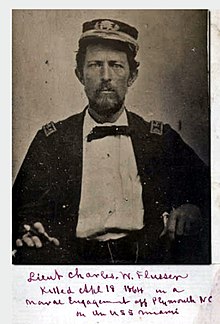Battle of Plymouth (1864)
 From Wikipedia - Reading time: 6 min
From Wikipedia - Reading time: 6 min
| Battle of Plymouth | |||||||
|---|---|---|---|---|---|---|---|
| Part of the American Civil War | |||||||
 | |||||||
| |||||||
| Belligerents | |||||||
|
|
| ||||||
| Commanders and leaders | |||||||
|
Henry W. Wessells Charles W. Flusser † | Robert F. Hoke | ||||||
| Units involved | |||||||
| Plymouth Garrison | Hoke's Division | ||||||
| Strength | |||||||
| 2,500 | 4,500 | ||||||
| Casualties and losses | |||||||
|
2,000 | 800 | ||||||
The Battle of Plymouth was an engagement during the American Civil War that was fought from April 17 through April 20, 1864, in Washington County, North Carolina.
Battle
[edit]
In a combined operation with the ironclad ram CSS Albemarle, Confederate forces under Maj. Gen. Robert F. Hoke, attacked the Federal garrison at Plymouth, North Carolina, on April 17. On April 19, the ram appeared in the river, sinking the USS Southfield, damaging the USS Miami, and driving off the other Union Navy ships supporting the Plymouth garrison. Confederate forces captured Fort Comfort, driving defenders into Fort Williams. On April 20, the garrison surrendered.


Plymouth citizens are believed to have taken refuge in the basement of the Latham House during the Battle of Plymouth.[1]
Order of battle
[edit]Union forces
[edit]Plymouth Garrison: Brig. Gen. Henry W. Wessells
- 1st North Carolina Infantry (Union)
- 2nd North Carolina Infantry (Union)
- 101st Pennsylvania Infantry
- 103rd Pennsylvania Infantry
- 16th Connecticut Infantry
- 85th New York Infantry
- 10th US Colored Infantry
- 37th US Colored Infantry
- 2nd US Colored Cavalry
- 12th New York Cavalry
- 2nd Massachusetts Heavy Artillery
- 24th New York Independent Battery
Naval: Lt. Cdr. Charles W. Flusser (k)
Confederate forces
[edit]Hoke's Division: Brig. Gen. Robert F. Hoke
- Hoke's Brigade: Col. John T. Mercer (k)
- 6th North Carolina Infantry
- 21st North Carolina Infantry
- 43rd North Carolina Infantry
- 54th North Carolina Infantry
- 21st Georgia Infantry
- Ransom's Brigade: Brig. Gen. Matt W. Ransom
- 8th North Carolina Infantry
- 24th North Carolina Infantry
- 25th North Carolina Infantry
- 35th North Carolina Infantry
- 49th North Carolina Infantry
- 56th North Carolina Infantry
- Kemper's Brigade: Col. William R. Terry
Dearing's Command: Col. James Dearing
- 8th Confederate Cavalry
- Virginia Horse Artillery Battery
Branch's Battalion
- Pegram's Battery
- Miller's Artillery
- Bradford's Battery
Moseley's Battalion
- Montgomery (Alabama) True Blues Artillery
- Wilmington Light Artillery
Guion's Battalion
- 1st North Carolina Artillery (Companies B, G and H)
Read's Battalion
- 38th Virginia Light Artillery Battalion
- Fauquier Artillery (Co. A)
- Richmond Fayette Artillery (Co. B)
- Bloundt's Lynchburg Artillery (Co. D)
Naval
External links
[edit]References
[edit]- ^ Janet K. Seapker and John B. Flowers III (n.d.). "Latham House" (PDF). National Register of Historic Places – Nomination and Inventory. North Carolina State Historic Preservation Office. Retrieved 2015-06-01.
 KSF
KSF